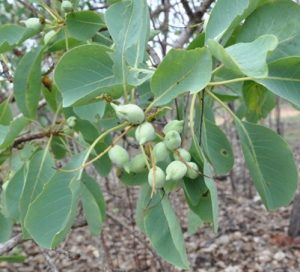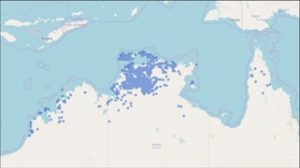Gubinge
Terminalia ferdinandiana
Gabiny Yawuru
Yami-nyarri Karajarri
arngul, madoorr, gubinge Bardi
Kabiny Nyul Nyul
Flowering: Flowers Laja to Mangala between October and March
Fruiting: in Man-gala between December and February

The Gubinge is a highly valued Kimberley plant. It is sometimes referred to as the Billygoat plum or Kakadu plum as related species occur in the Northern Territory. Gubinge trees can grow to 14m and are found in open woodlands and in vine thickets around Broome and the Dampier Peninsula. Locally there are many thriving plants in Minyirr Park and other bush areas.
It’s a deciduous tree with bright green leaves. Young leaves often are tinged with pink, and some species also have pinkish fruit. The flowers are delicate white clusters and
The gubinge fruit is considered to be one of the richest natural sources of Vitamin C in the world (about 50 times the vitamin C of an orange). Eaten raw it has an astringent fresh taste that can be strong. Cooked, it can be a jam or even turned into a syrup or cordial for drinking. It’s a very popular fruit and Gubinge cultivation is increasing with a number of industries interested in the medicinal and cosmetic values that the rich fruit can provide.

The fruit has a large seed which is also edible, and is often smashed to retrieve the inner kernel which have an apricot flavour. The bark has medicinal value when treated as an infusion or heated and then applied to the skin to soothe rheumatism or other aches
The inner bark of the tree is also very useful; it can be used as an anti-fungal to treat skin disorders and infections including wounds, sores and boils. It is also effective in controlling fungal infections such as ringworm, and in the treatment of bacterial infections including its use in treating leprosy.
There are a number of different varieties with local names. Which ones have you tried?
- PeeWees – as the name suggests, they are small, but they taste sweet and tangy
- Diamond in the Rough- the fruit are large and thick skinned
- Pink Blush- they have a pretty rose coloured tinge and are sweet to eat
- Bird Beak- self explanatory; they have protruding pointed end
- Kimberley Commons – these are yor classic gubinge found all over Broome.
- Dampier Peninsula Sultanas- they are smaller, and the fuit clusters little bunches of grapes
- White Pearl- they are a player colour and have a smooth flavour
(ex: Kimberley Wild Gubinge)
For more information: “Broome and Beyond; Plants and people of the Dampier Peninsula, Kimberley, Western Australia” full reference page 88.
